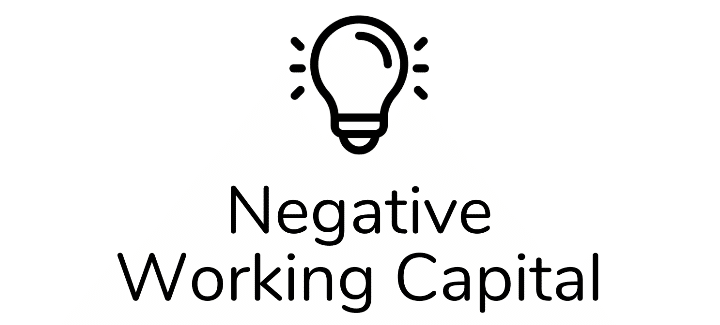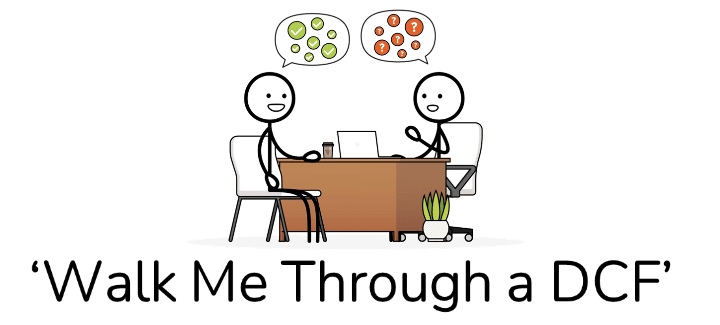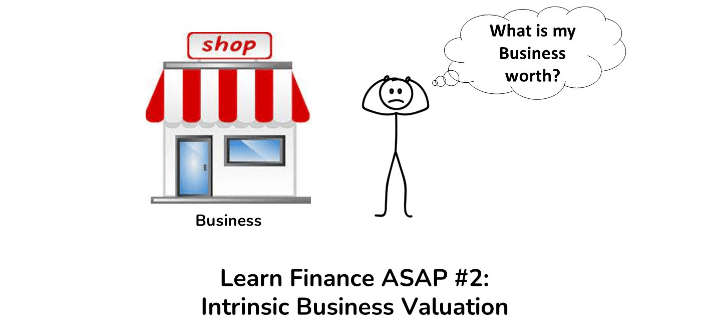Learn the top Investment Banking Interview Questions you’ll need to master in order to land a coveted role in Investment Banking.
In this guide, we’ll cover the most common Investment Banking interview questions that you will encounter.
For now, we’ll focus solely on the most common Investment Banking Technical Questions and Answers.
Over the coming months, we’ll be adding many more Technical IB Interview Questions as well as Behavioral Interview Questions.
In the end, we’re aiming to make this a comprehensive Investment Banking Interview Prep study guide to help you in your journey toward a career in Investment Banking.
We hope you find it helpful!
- IB Interview Questions: Market Knowledge
- IB Interview Questions: Industry Knowledge
- IB Interview Questions: Accounting
- Level 1 Accounting Questions
- Level 2 Accounting Questions
- Level 3 Accounting Questions
- IB Interview Questions: Valuation
- Level 1 Valuation Questions
- Level 2 Valuation Questions
- Level 3 Valuation Questions
- IB Interview Questions: M&A
- Level 1 M&A Questions
- Level 2 M&A Questions
- Level 3 M&A Questions
- IB Interview Questions: LBO
- Level 1 LBO Questions
- Level 2 LBO Questions
- Level 3 LBO Questions
IB Interview Questions: Market Knowledge

What are your thoughts on the market?
Interviewers often ask for your view on the latest trends and events in the market.
We recommend keeping up with the latest events by regularly reading the Wall Street Journal as well as The Hustle and ExecSum daily newsletters.
If you subscribe to the latter two and read them daily, you’ll be super well prepared to discuss current events in the market during your interview.
What is the latest value for….?
You should prepare to provide the latest trading values for:
- The S&P 500
- The 10 US Treasury
- The Nasdaq
- S&P 500 Forward P/E
- The exchange rate for the British Pound (or Euro) vs the dollar
Make a mental note of the trading values for each of these items before your interview.
You can find the latest trading values for all of these things on Koyfin.
IB Interview Questions: Industry Knowledge

What do Investment Bankers do? How does that compare to S&T? What about Private Equity?
Investment Bankers advise their clients on the sale or purchase of a business. They also help companies raise money by issuing stock, bonds, or other related securities.
Sales and Trading buy and sell securities on behalf of their clients or bank.
Private Equity buys companies in Leveraged Buyout (i.e. LBO) transactions with the aim of increasing the value and selling the companies in a few years for a profit or take the company public.
For a simple explanation of all of the players above (and what each does), check out this animated explainer video on the Buy Side vs Sell Side.
What is Bulge Bracket vs Boutique bank? How do they differ?
Bulge bracket banks typically are larger, offer more products, and perform more deals throughout the year.
Boutique banks are typically smaller, with more specific areas of expertise (often M&A and Restructuring).
For more detail on the different types of banks and check out this simple explainer video.
What is in a pitchbook?
A pitchbook is a slide presentation created by an Investment Banker to present to clients.
The typical pitchbook contains: bank credentials (or ‘creds’), a recent market overview, and recommended actions (e.g. raise debt, buy or sell a company, etc.). This latter section is often called ‘Strategic Options’ or ‘Strategic Alternatives.
See how Investment Bankers create pitchbooks with this simple explainer video.
IB Interview Questions: Accounting

Level 1 Accounting Questions
Accounting and Financial Statement Basics
Walk me through the Three Financial Statements
The three financial statements are the Income Statement, the Balance Sheet, and the Statement of Cash Flows (or Cash Flow Statement).
The Income Statement shows the profitability of a company over a period of time on an Accounting (i.e. Accrual) basis.
The key items on the Income Statement are Revenue (i.e. Sales) less Cost of Goods Sold, Selling General and Administrative Expense, Interest Income / (Expense), Other Income (Expense), and Income Taxes. The bottom of the Income Statement shows Net Income which reflects the net profit on an accrual basis over a period of time.
The Balance Sheet shows the company’s Assets (i.e. what it owns), Liabilities (i.e. what it owes), and Equity (owner investment + accumulated profit – dividends) at the time of reporting. It’s called a balance sheet because Assets must equal Liabilities plus Owners Equity.
The Statement of Cash Flows shows us the underlying drivers of the net change in cash during a period of time. The three major sections of the Cash Flow Statement are the Cash Flows from Operations (CFO), Cash Flows from Investing (CFI) and Cash Flows from Financing (CFF).
For a deeper dive, check out the following videos:
What is the difference between Cash and Accrual-Basis accounting?
Cash Basis accounting reflects dollars in and out. Accrual Basis Accounting reflects Revenue when it’s earned Expenses when they are incurred, regardless of the Cash that changes hands.
What is the impact of Debits/Credits on Assets and Liabilities?
A Debit increases an Asset account, while a Credit decreases an Asset account.
Conversely, a Debit decreases a Liability account, while a Credit increases an Asset account.
What is the Revenue Recognition principle?
The Revenue Recognition Principle states that revenues should be recognized when the sale of a service or good has been earned and the transaction is substantially complete…not when the cash is received.
What is the Matching principle?
The Matching Principle states that we have to recognize (i.e. ‘match’) Expenses in the same period in which the Revenues (arising from those expenses) are earned.
The Income Statement
What is included in COGS?
Cost of Goods Sold (COGS) includes all expenses incurred to produce a good or service, such as raw materials and labor.
For a deeper dive, check out the following video:
What is included in OpEx?
Operating Expense (or ‘OpEx’) is simply another name for Selling, General and Administrative (‘SG&A’) expense. OpEx includes all of the indirect expenses needed to run a business that aren’t directly tied to the products or services a business sells. OpEx typically includes overhead costs as well as marketing and selling expenses.
For a deeper dive, check out the following video:
What is the difference between Cost of Goods Sold (COGS) and Selling General and Administrative (SG&A) Expense?
COGS expense reflects all of the expenses required to produce the goods or services sold by a Business.
SG&A expense reflects all overhead costs not directly tied to the production or delivery of the goods or services sold by a Business. SG&A also includes the sales and marketing costs.
For a deeper dive, check out the following videos:
How does Gross Profit differ from Operating Profit at a pizza shop?
Gross Profit is the money received for all Pizzas sold less the cost of dough, sauce, etc. Operating Profit goes a step further and subtracts the cost of marketing and sales as well as overhead items like rent and employee salaries.
For a deeper dive, check out the following videos:
What is EBITDA?
EBITDA stands for Earnings Before Interest, Taxes, Depreciation, and Amortization. EBITDA is a profit metric that is often called a ‘Cash Flow Proxy’ because it excludes non-cash charges like Depreciation and Amortization.
For a deeper dive, check out the following video:
What does ‘Above the Line’ / ‘Below the Line’ mean?
‘Above the Line’ includes all Income Statement items above EBIT (including EBITDA).
‘Above the Line’ metrics reflect the core operations of the business independent of the impact Interest Expense from Debt.
These metrics are common in IB because bankers advise on buying/selling companies (and wipe out Debt/Equity in the process) and/or recapitalizing Debt/Equity, so they look at companies absent the impact of Debt.
For a deeper dive, check out the following video:
The Balance Sheet
What’s the difference between Accounts Receivable (AR) and Deferred Revenue (DR)?
If a company is paid before a sale is earned and substantially complete, we record Deferred Revenue. If a company is paid after a sale is earned and substantially complete, then we record Accounts Receivable.
For a deeper dive, check out the following:
- Video: Balance Sheet Basics Explained
- Course: Accounting Fundamentals Mastery
What does it mean to ‘Capitalize’ an item to the Balance Sheet?
Capitalization is the process of recording an expense on a Company’s Balance Sheet as an Asset and expensing it in proportion to its useful life over time.
An example of this would be the treatment of Property, Plant, and Equipment (PP&E). With PP&E, we initially record the purchase value of the asset to the Balance Sheet.
We then record Depreciation Expense over the estimated useful life of the PP&E as we use it up.
Each time we record Depreciation Expense it lowers the value of Net PP&E on the Balance Sheet (via Accumulated Depreciation).
What is the difference between a current and non-current Asset/Liability?
Current Assets are Assets that are expected to turn into cash within a year (or one operating cycle), while non-current assets are expected to turn into cash beyond a year.
Similarly, Current Liabilities reflect obligations due within one year (or one operating cycle), while non-current liabilities are due beyond one year.
Working Capital and Capital Intensity
How do you calculate Net Working Capital?
Net Working Capital is calculated as Current Assets (excluding Cash) minus Current Liabilities.
For a deeper dive, check out the following videos:
What’s the difference between Accounts Receivable and Deferred Revenue?
If a company is paid before a sale is earned and substantially complete, we record Deferred Revenue. If a company is paid after a sale is earned and substantially complete, then we record Accounts Receivable.
What’s the difference between Prepaid Expenses and Accrued Liabilities?
If a company pays for an expense before it is incurred, we record Prepaid Expenses. If a company pays after an expense is incurred, then we record an Accrued Liability.
The Cash Flow Statement
Describe Cash Flows from Operations (CFO) in Plain English
CFO reflects the cash generated by the operations (i.e. sales of goods and services) over a period of time. Another way to look at CFO is that it reflects cash Net Income.
To calculate CFO, we begin with Net Income, add back any non-cash charges and then make adjustments for changes in operating Assets and Liabilities (i.e. ‘Working Capital’).
For a deeper dive, check out the following video:
Describe Cash Flows from Investing (CFI) in Plain English
The Cash Flows from Investing section of the Cash Flow Statement reflects reinvestments in the business (‘Capital Expenditures’ and/or Purchases of Intangibles), payment for Business Acquisitions, and the purchase or sale of Investment Securities (i.e. Stocks and Bonds).
For a deeper dive, check out the following video:
Describe Cash Flows from Financing (CFF) in Plain English
The Cash Flows from Financing section of the Cash Flow Statement reflects cash in and out from Lenders and Investors.
With respect to our Lenders, this section reflects the cash flows from raising debt and cash outflows from paying off debt (note: this section does not include interest expense under US GAAP).
With respect to Investors, this section reflects cash inflows from raising Investor (or Equity) capital and cash outflows from Dividends and Share Buybacks.
For a deeper dive, check out the following video:
If you could only have two of the three financial statements, which would you choose and why?
The Income Statement and Balance Sheet because you can derive a Cash Flow Statement from them.
What is the most important of the three financial statements?
The Cash Flow Statement is the most important of the three because it shows you the actual change in Cash.
The change in Cash is critical because a business will stop when it runs out of Cash.
By contrast, the Income Statement and Balance Sheet are presented on an Accrual Basis.
For a deeper dive, check out the following video:
Level 2 Accounting Questions
Three Statement Connections/Flows
How would we account for a purchase of Inventory if we pay for it today? What is the Income Statement impact if we haven’t sold the Inventory to a Customer?
We would reduce Cash and increase Inventory at the time of the initial purchase. But we don’t record any Income Statement impact until the Inventory is sold to a Customer.
Want to Learn More:
How are the Three Financial Statements connected?
Net income at the bottom of the Income Statement flows to Retained Earnings in the Balance Sheet and to CFO at the top of the Cash Flow Statement.
In the Cash Flow Statement, we add back non-cash items like Depreciation and adjust for changes in Net Working Capital, to arrive as Cash Flow from Operations.
In Cash Flows from Investing, we then deduct Capital Expenditures (based on the PP&E account in the Balance Sheet).
Finally, in Cash Flows from Financing, we adjust for Lender and Investor cash inflows/outflows based on our Debt and Equity accounts.
After these adjustments, we arrive at our Net Change in Cash which bridges the Cash Balance from the prior period to the current period.
Walk me through the 3 Financial Statement impacts if Depreciation increases by $10?
The $10 Depreciation Expense reduces Taxable Income by $10 which creates a tax credit of $2 ($10 Depreciation * 20% Tax Rate).
The net impact to Net Income is ($8) which carries to CFO where we add the $10 Depreciation back which results in a net impact to CFO of +$2.
The +$2 of CFO flows down to a Net Change in cash of +$2.
The +$2 Cash impact increases the Cash account by +$2 and PP&E decreases by the ($10) Depreciation expense, leading to a net impact to Assets of ($8).
The offsetting entry is adding the ($8) Net Income impact to Retained earnings to balance the Balance Sheet.
For a deeper dive, check out the following video:
Cash and Working Capital Dynamics
Why isn’t cash part of Working Capital?
Cash is a ‘Non-Operating Asset’ as opposed to items like Inventory, Accounts Receivable, etc. which are ‘Operating Assets.’
In plain English, Cash is an output of the business and is not employed in the business’ operations.
By comparison, an item like Accounts Receivable is directly employed in the business.
How do you calculate Unlevered Free Cash Flow?
The formula for Unlevered Free Cash Flow is: EBIT – Tax + D&A – CapEx +/- Changes in Net Working Capital.
The formula can also be presented as: EBIT * (1 – T) + D&A – CapEx +/- Changes in NWC
As the owner of a business, how would you explain: EBIT – Tax + D&A – CapEx +/- Changes in Net Working Capital…in Plain English?
This is my after-tax profit (in cash) after taking into account reinvestment back into the business.
What is the difference between EBITDA and (Unlevered) Free Cash Flow?
EBITDA reflects EBIT (Profit) + D&A (Non-Cash Items) but leaves out Capital Intensity (CapEx + NWC) and Taxes.
Unlevered Free Cash Flow (UFCF) incorporates all three of those items. This is why EBITDA is called a ‘Cash Flow Proxy.’
Note that if the interviewer doesn’t specify Levered vs Unlevered Free Cash Flow, you should probably assume they are referring to Unlevered Free Cash Flow.
For a deeper dive, check out the following video:
Is an increase/decrease in an Asset or Liability a Source or Use of Cash?
An increase in an Asset is a Use of Cash, whereas a Decrease in an Asset is a Source of Cash.
An increase in a Liability is a Source of Cash, whereas a Decrease in a Liability is a Use of Cash.
This question can come in the format shown above as well as, ‘Would an increase/decrease in [Balance Sheet Account] create a Source or Use of Cash?’
Either way, the answer follows the rules listed above for both Assets and Liabilities.
For a deeper dive, check out the following videos:
What is Capital Intensity and how does Working Capital play a role in a business?
Capital Intensity is the combination of Capital Expenditures and Net Working Capital.
In Plain English, these two items simply represent the reinvestments needed to maintain (and grow) the business.
For a deeper dive, check out the following video:
One business outsources manufacturing and another doesn’t, which has lower Capital Intensity?
The business that outsources has lower Capital Intensity. Capital Intensity is a function of Capital Expenditures and Net Working Capital. In the case of this question, a business that outsources has lower Capital Expenditures and thus lower Capital Intensity.
What is Negative Net Working Capital?
First, Net Working Capital (NWC) is Current Assets (Excl Cash) – Current Liabilities. Negative Net Working Capital comes about when Current Liabilities are greater than Current Assets (excl Cash).
Negative NWC results from suppliers (Inventory), service providers such as landlords, employees, etc. (Accrued Liabilities), or customers (Deferred Revenue) that lend us money in advance of either Revenue being earned or an Expense being incurred.
For a deeper dive, check out the following video:
How can a company show positive net income but have zero cash flow?
The most likely reason for this would be that we recorded revenue in the Income Statement but hadn’t collected cash yet.
This is because accounting reflects the underlying economic substance of transactions and not cash flows.
How could we make significant operating cash flow and show zero net income?
If a business generated significant cash flow from selling subscriptions (i.e. Deferred Revenue), it would generate significant Cash Flow.
However, the earnings from the subscriptions would not be recorded until the service underlying the subscription had been earned.
As such, at the outset, the company would show zero Net Income.
Level 3 Accounting Questions
Three Statement Impacts
If I buy a piece of equipment in cash for $100, how does it impact the three financial statements? (20% tax rate)
There is Zero impact to the Income Statement at the time of the initial purchase.
However, we record ($100) Capital Expenditures in Cash Flows from Investing which results in a ($100) Change in Cash.
The ($100) decrease in Cash lowers the cash account by ($100).
The offsetting entry to balance the Balance Sheet is to increase PP&E by +$100.
For a deeper dive, check out the following video:
Walk me through the impact of a $10 increase in PIK Interest across the 3 financial statements? (20% tax rate)
The $10 PIK Interest reduces Taxable Income by $10 which creates a tax credit of $2 ($10 PIK Interest * 20% Tax Rate).
The net impact to Net Income is ($8) which carries to CFO where we add the $10 PIK Interest back which results in a net impact to CFO of +$2, which flows down to a Net Change in Cash of +$2.
The +$2 Cash impact increases the Cash account by +$2.
On the other side of the Balance Sheet, the Debt account increases by the +$10 PIK Interest expense and we deduct the ($8) Net Income impact in Retained earnings to balance the Balance Sheet.
For a deeper dive, check out the following video:
We use cash to pay off $100 of Debt at face value. How does that affect the 3 financial statements? (20% tax rate)
Zero impact to the Income Statement from this transaction.
($100) Debt Paydown in Cash Flows from Financing which results in a ($100) Change in Cash.
The ($100) decrease in Cash lowers the cash account by ($100).
The offsetting entry to balance the Balance Sheet is to reduce Debt by ($100).
For a deeper dive, check out the following video:
As a business owner do you prefer positive or negative net working capital if you know the business will grow forever?
You would choose the business with Negative Working Capital because it will generate extra cash from the Negative Working Capital as it grows into perpetuity.
For a deeper dive, check out the following videos:
A Company has negative Net Working Capital (NWC), NWC is proportional to Sales. If the business doubles, what’s the impact to Cash from NWC?
There will be a positive impact to Cash. If a company has Negative Net Working Capital, that means that Current Liabilities are greater than Current Assets.
If both grow proportional to sales, the absolute dollar growth in Current Liabilities will exceed the growth in Current Assets, resulting in an increase in Liability on a net basis, which is a Source of Cash.
The rule of thumb is that if a company has Negative Net Working Capital (and all the underlying components) are proportional to revenue…and revenue grows…it will result in a cash inflow from Net Working Capital…and if the Revenue declines, there will be a cash outflow from Net Working Capital.
Negative Net Working Capital is a tricky concept, but if you can remember this rule of thumb, then you’re in good shape.
For a deeper dive, check out the following videos:
Deferred Tax Assets and Liabilities
What gives rise to Deferred Taxes?
GAAP and IRS Tax accounting rules are often quite different from each other.
When there are disconnects between the two that will revert over time, those disconnects result in temporary differences which create Deferred Tax Assets and Liabilities.
If you owe more IRS tax now (relative to GAAP tax) it creates a Deferred Tax Asset.
If you owe less IRS tax now (relative to GAAP tax) it creates a Deferred Tax Liability.
What impact does a $10 increase in Deferred Tax Assets (or Liabilities) have on Cash Flow? Why?
This seems like a trick question, but Deferred Tax Assets and Liabilities follow the same rules for Sources and Uses of cash as traditional Working Capital items.
An Increase in an Asset is a Use of Cash, whereas a Decrease in an Asset is a Source of Cash.
An Increase in a Liability is a Source of Cash, whereas a Decrease in a Liability is a Use of Cash.
Bonus depreciation allows you to take 100% depreciation for tax purposes in year 1. Does this create a Deferred Tax Asset or Liability?
Bonus Depreciation creates a significant deduction today which lowers our tax bill now, but we have no future deductions so we pay more tax later.
Lower tax paid now, more tax paid later results in a Deferred Tax Liability.
If you run a subscription business where customers prepay for multiple years of service, does this create a Deferred Tax Asset or Liability?
If customers prepay for future years of service, the IRS is likely to require taxes to be paid before the Revenue is recognized.
This results in a higher tax bill in the early years and lower taxes in later years. More tax paid now and less tax paid in the future results in a Deferred Tax Asset.
IB Interview Questions: Valuation
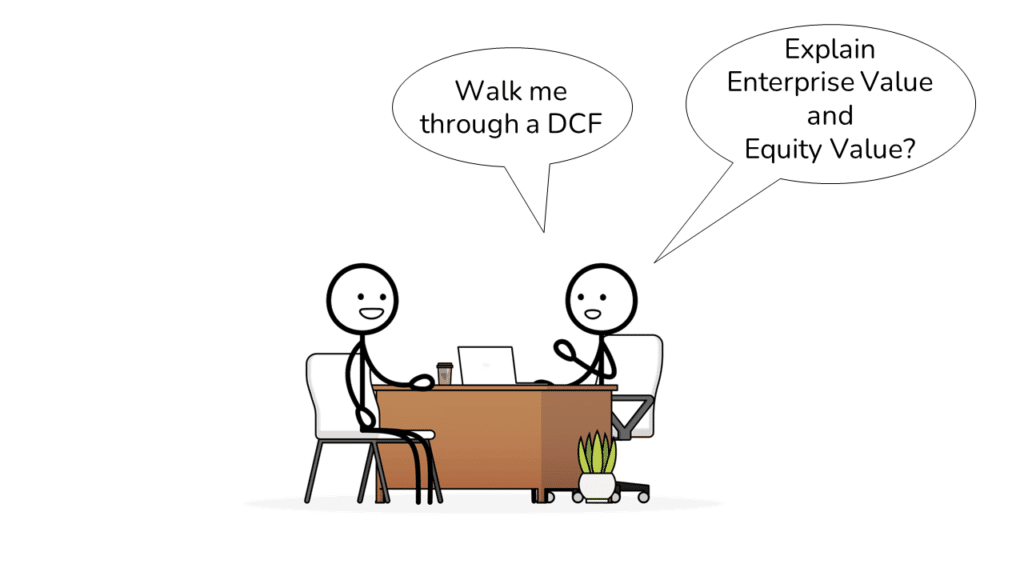
Level 1 Valuation Questions
Valuation Big Picture
What are the three most common valuation methods?
There are three primary valuation methods. The first is Discounted Cash Flow Analysis (DCF) in which we value the Cash Flows of the Business.
Next, we could look at the valuations of similar Publicly Traded Businesses, which is called Trading Comparables (or ‘Trading Comps’).
The final primary approach is Transaction Comparables (or ‘Precedent Transactions’) where we look at the valuations of similar businesses that have been sold in the past.
For a deeper dive, check out the following video:
Which of the primary valuation methods are ‘Intrinsic’ vs ‘Relative/Market-Based?’
The DCF approach is an ‘Intrinsic’ valuation because we’re looking at the value of underlying Cash Flow.
Both of the Comparables Analyses (Trading and Precedent Transactions) use peer valuations and thus are considered Relative or Market-based Valuations.
For a deeper dive, check out the following video:
When we say we “triangulate” to a value, what does that mean? What methods might we use?
When valuing a business, we typically look at multiple valuation approaches (DCF, Trading Comps, Transaction Comps, LBO, etc.) and make a judgment call about the most appropriate valuation range.
Are there other methods of Business Valuation?
Yes, there are two other commonly used methods: LBO Valuation and Liquidation Analysis.
With an LBO analysis, we look at what a Private Equity firm could pay in a Leveraged Buyout (LBO) purchase and still achieve an attractive return.
With a Liquidation (or ‘Asset-Based’) Valuation, we assume the company liquidates all of its Asset (typically at a large discount to book value) and pays off all outstanding debts.
How would you value a Taco Stand?
You could use one of the three primary valuation methods: Discounted Cash Flow Analysis, Trading Comparables, or Transaction Comparables and you’d triangulate to a range of values based on the outputs of those three methods.
What is a “Football Field” in the context of valuation?
A Football Field is a common chart in Investment Banking that lays out the range of valuations for a particular company across multiple valuation methods (DCF, Comps, LBO, etc.).
Discounted Cash Flow Analysis Fundamentals
What are Stage 1 and Stage 2 within a DCF analysis?
Stage 1 reflects the Explicit Projection Period in which we construction detailed cash flow projections.
Stage 2 (also called ‘Terminal Value’) reflects all value beyond Stage 1. During this phase, we make simplifying assumptions around the long-term performance of the business to value all Cash Flows beyond Stage 1.
For a deeper dive, check out the following video:
For how many years do you project into the future in your Stage 1?
Typically, you project out 5-10 years or until the business reaches maturity…or a ‘steady-state’.
Most candidates memorize the ‘5-10 years’ answer. Interviewers ask this to see if you understand that the real goal is to project until the business hits a ‘steady-state’, from which you can make simplifying assumptions about long-term growth.
For a deeper dive, check out the following video:
What is Terminal Value?
Reflects the discounted value of all Cash Flow beyond the explicit projection project period (Stage 1) for a DCF analysis.
How do we calculate Free Cash Flow in a DCF?
Unless you’re explicitly asked to calculate ‘Levered Free Cash Flow‘, you should assume that you need to calculate ‘Unlevered’ Free Cash Flow (i.e. excluding the impact of debt).
The formula for Unlevered Free Cash flow is: EBIT – Tax + D&A – CapEx +/- Changes in Net Working Capital. This calculation gets us to the underlying cash generated by the business irrespective of its capital structure (i.e. Debt/Equity mix)
For a deeper dive, check out the following video:
Weighted Average Cost of Capital
What is a Discount Rate?
A rate of return that is used to value future cash flows in terms of today’s dollars. The rate of return used should be proportional to the riskiness of the Cash Flows that are being valued.
What is WACC in plain English?
The Weighted Average Cost of Capital (WACC) shows us the overall cost of capital for a business by blending the costs (i.e. expected returns) of all sources of capital (e.g. Equity, Debt, etc.).
What is the Cost of Equity Formula?
The Cost of Equity formula reflects the expected return for investors in a business.
The formula for the Cost of Equity is:
Risk Free Rate + Beta * Equity (or Market) Premium.
The formula begins with the Risk-Free Rate (usually the 10 Year US Treasury). This gives us a baseline for the Minimum Return we should expect if we’re taking zero risk.
We then add a reward for taking incremental Risk in the form of Beta (which characterizes the volatility/riskiness of an individual stock) and multiply Beta by the Equity Risk Premium (which reflects the historical Reward for investing in Stocks vs Bonds over time).
For a deeper dive, check out the following video:
Why do we use the 10 Year US Treasury?
We typically use the 10 Year US Treasury for two reasons:
- The US is the reserve currency of the world and as such we assume the US will always repay, thus making an investment in US securities ‘Risk Free.’
- We use a long-dated Treasury Security like the 10 Year Treasury to match the time frame of the cash flows we are attempting to value. In short, because our valuation assumes the business will last for a long period of time, we use a risk free security with a longer life.
What does Beta measure?
Beta measures a stock’s volatility in relation to the market. The underlying idea is that the more a stock moves relative to the market, the more risky the stock is.
When Beta is less than 1.0, a stock will move less than the market (i.e. it’s less risky).
When a Beta is greater than 1.0, a stock will move more than the market (i.e. it’s more risky).
How is Beta calculated?
Beta results from a Regression Analysis comparing the movement of a single stock versus the market (typically the S&P 500). The regression typically looks at 3-5 years of historical data.
What is the Equity/Market Risk Premium…in Plain English?
The Equity (or Market) risk premium reflects the excess reward for investing in Equities (i.e. Stocks) versus risk-free bonds.
How is the Equity/Market Risk Premium calculated?
The Equity (or Market) risk premium is typically calculated as the difference between the historical return of the market (usually the S&P 500) vs risk-free bonds (typically the 10 Year Treasury) over a multi-decade period of time.
Enterprise Value vs Equity Value
What is Enterprise Value…in Plain English?
Enterprise Value reflects the Purchase Price of an entire Business without taking into account how the business was funded.
For a deeper dive, check out the following video:
What is Equity Value…in Plain English?
Equity Value reflects the value attributable to the owner of a Business after accounting for payments to lenders (i.e. Debt) and any excess Cash in the bank that belongs to the owner of the Business.
For a deeper dive, check out the following video:
Level 2 Valuation Questions
DCF and WACC Concepts
Walk me through a DCF analysis
The steps to walk through a DCF analysis are:
- Project future Cash Flow until the business reaches maturity (usually 5-10 years).
- Calculate Terminal Value.
- Discount the Projected Cash Flows and Terminal Value using WACC.
- Work from Enterprise Value to Equity Value by subtracting Debt and adding Cash.
- Calculate Price per Share by dividing Equity Value by the Number of Shares.
Remember to keep it high-level!
If you want to master this question, check out our deep-dive Walk Me Through a DCF article.
This is far and away one of our most popular articles as it covers all DCF concepts from start to finish. Definitely check it out!
All else equal, which comp method (trading or transaction) will result in a higher valuation? Why?
Precedent Transactions analysis typically results in a higher valuation because you have to pay a ‘Control Premium’ to acquire an entire business vs buying a smaller stake.
Why is the LBO valuation generally referred to as a “floor” valuation?
An LBO firm typically doesn’t own a competing asset to a target company it acquires and thus can’t generate Synergies. This typically results in the lowest purchase price (vs Corporate Acquirers).
To explain further, when a Corporate (or ‘Strategic’) buyer makes an acquisition, they can typically generate Synergies which raises profit and thus justifies a higher acquisition price. An LBO firm typically can’t generate synergies and can’t justify as high of a price.
Walk me through the Cost of Equity (i.e. CAPM) formula…in Plain English.
The formula starts with the Risk-Free Rate (usually the 10 Yr US Treasury).
This gives us a baseline for the Minimum Return we should expect if we’re taking zero risk.
We then add a reward for taking incremental Risk in the form of Beta (which characterizes the volatility/riskiness of an individual stock) and multiply Beta by the Equity Risk Premium (which reflects the historical Reward for investing in Stocks vs Bonds over time).
For a deeper dive, check out the following video:
What is a reasonable terminal growth rate? Why?
You should assume long-term growth in line with GDP growth for your Terminal Value calculation. Otherwise, you will outgrow the economy.
What are the two most common methods for calculating Terminal Value?
The two most common approaches are the Perpetuity Growth Method and the Exit Multiple Method.
In the Free Cash Flow Formula, why do we start with EBIT * (1-T)…as opposed to EBITDA * (1-T)?
EBIT takes into account Depreciation and Amortization (‘D&A’) which is a non-cash expense that lowers our taxes owed.
In short, Depreciation ‘shields’ us from tax liability and so the D&A impact is referred to as the ‘Depreciation Tax Shield’.
For a deeper dive, check out the following article and video:
What is the Depreciation tax shield in the Unlevered Free Cash Flow calculation?
When we calculate Taxes in our Unlevered Free Cash Flow, we calculate taxes based on EBIT, which incorporates Depreciation and Amortization (D&A) as a deduction.
This lowers our taxable income (even though D&A are non-cash charges), which in turn lowers our taxes owed.
We then add D&A back in the calculation because it’s non-cash. In short, D&A lowers (i.e. shields) our taxes owed.
For a deeper dive, check out the following article and video:
Why don’t we include interest in the Unlevered Free Cash Flow calculation?
‘Unlevered’ means you do not include anything connected to leverage, such as interest expense.
In short, we look at the cash flow absent the impact of debt and discount it by the weighted average cost of capital which reflects the blended expected returns of all capital providers (Debt and Equity).
In the end, we arrive at the total value of the business (i.e. Enterprise Value) absent the impacts of Debt and Equity.
Why do we look at the cost of debt on an after-tax basis?
Interest is tax-deductible for a business and so the real cost of Debt is the after-tax interest cost.
All else equal, which should be higher: Cost of Equity or Cost of Debt?
Usually, the Cost of Equity is greater than the Cost of Debt.
This is because the lenders to a business take less risk because they are paid first in the event of a sale or bankruptcy.
In contrast, Investors aren’t paid until after all Lender claims have been satisfied and thus take more risk.
Why is WACC characterized as an ‘Opportunity Cost of Capital?’
WACC is characterized as an opportunity cost of capital because it represents the level of risk and foregone investments taken by investors
Do we use market or book value for our Debt/Equity weightings in the WACC formula?
We typically use book value for the Debt weighting and Market Value for the Equity weighting in the Weighted Average Cost of Capital Formula.
What is the formula to un-lever Beta?
The formula to un-lever Beta is: Levered Beta / (1 + [D/E])*(1-T))
What is the formula to re-lever Beta?
The formula to re-lever Beta is: Unlevered Beta * (1 + [D/E])*(1-T))
How do we find the Beta of a Private Company?
To find the Beta of a Private company, we find the Beta for several publicly traded peers. We then un-lever the peer Betas, take the average of the peer Betas, and re-lever the average with the target capital structure of the company we are valuing.
Enterprise Value vs Equity Value
What is the Enterprise Value Formula?
Enterprise Value = Equity Value (or ‘Market Capitalization’) + Debt – Cash + Minority Interests
For a deeper dive, check out the following video:
What is the Equity Value Formula?
Equity Value = Enterprise Value – Debt + Cash – Minority Interests
For a deeper dive, check out the following video:
A business has an EV of $100, Debt of $40, and Cash of $10. What is the company’s Equity Value?
Enterprise Value of $100 – $40 of Debt + $10 of Cash = $70 Equity Value
I read somewhere that cash is a “non-operating asset”. What does that mean?
Cash is an output of a business and not a part of the business. In contrast, Assets like Account Receiveable and Inventory are employed directly in the business and thus are ‘Operating Assets.’
Valuation Multiples
How do you value a business that is losing money?
For comparables analysis, you could use EV/Revenue multiples.
For a Discounted Cash Flow analysis, you’d have to project out until the business makes money and ultimately hits a steady-state level of growth.
Explanation:
This is a variant of, what multiple would you use to value a money-losing/early-stage business. It also tests whether you understand the overarching goal/process of building out a DCF analysis.
For a deeper dive, check out the following video:
When would you use EV/Revenue as opposed to EV/EBITDA?
You generally use EV/Revenue when a company doesn’t have EBITDA (i.e. EBITDA is negative) and/or hasn’t when the business hasn’t fully matured. EV/EBITDA is used when a business is near or at maturity with stable earnings.
First, if you have negative EBITDA, the multiple is meaningless, so interviewers want to see if you understand that. Second, a common follow-up here is…What would you use if a company just became profitable? The answer is that you’d probably still use EV/Rev because EBITDA likely doesn’t reflect mature margin levels.
For a deeper dive, check out the following video:
A startup business just became profitable in the most recent year reported. What is the right EV metric to use?
Because this company is still in the early stages of its development, an EV/Revenue multiple would likely be more appropriate until the company achieves a normalized (or ‘mature’) level of profitability.
The typical delineation between when to use EV/Revenue multiples as opposed to EV/EBITDA multiples is that you use EV/Revenue when a company is losing money. But there’s a bit of a grey area between initial profitability and full/mature margins in which judgment is required, which is what this question is testing.
For a deeper dive, check out the following video:
What is the difference between Levered and Unlevered multiples?
Unlevered multiples (EV/Revenue, EV/ EBITDA, etc.) do not take into account a company’s level of debt.
Conversely, Levered multiples (Price/Earnings, Price/Book etc.) do take into account a company’s level of debt.
What is the difference between an EV multiple and a P/E multiple?
Enterprise Value (EV) multiples measure a company’s Enterprise Value compared to an unlevered accounting metric like EBITDA or Revenue.
In contrast, P/E multiples measure the price of a company’s Equity Value compared to Net Income which is a levered metric.
Level 3 Valuation Questions
On some occasions, Preferred Stock is included in the WACC formula. Why is that the case?
The goal of WACC is to blend the cost of capital (i.e. the expected returns) of all of our capital providers. So if a company has Preferred Stock, we have to include the proportional costs of the Preferred Stock as well as regular Debt and Equity.
How do we incorporate Minority Interests into the Enterprise Value and Equity Value formulas? Why do we need to include Minority Interests in the first place?
When working from Enterprise Value to Equity Value, we subtract the value of Minority Interests.
When working from Equity Value to Enterprise Value, we add the value of Minority Interests.
Minority interests reflect a separate ownership claim on the equity of a business and thus must be accounted for.
EV is Equity + Net Debt. A business has a $100 EV, $40 of Debt, and $10 of cash and generates an extra $2 of cash, what’s the EV?
The overall purchase price of the business should remain the same, so the Enterprise Value is still $100.
If the question were asking about Equity Value, then we could say that Equity Value increased by $200.
There are a lot of red herrings in this question, but the key is to understand that Enterprise Value reflects the overall sale price of the Business.
If you want to master these concepts, check out our deep-dive article on Enterprise Value vs Equity Value.
IB Interview Questions: M&A
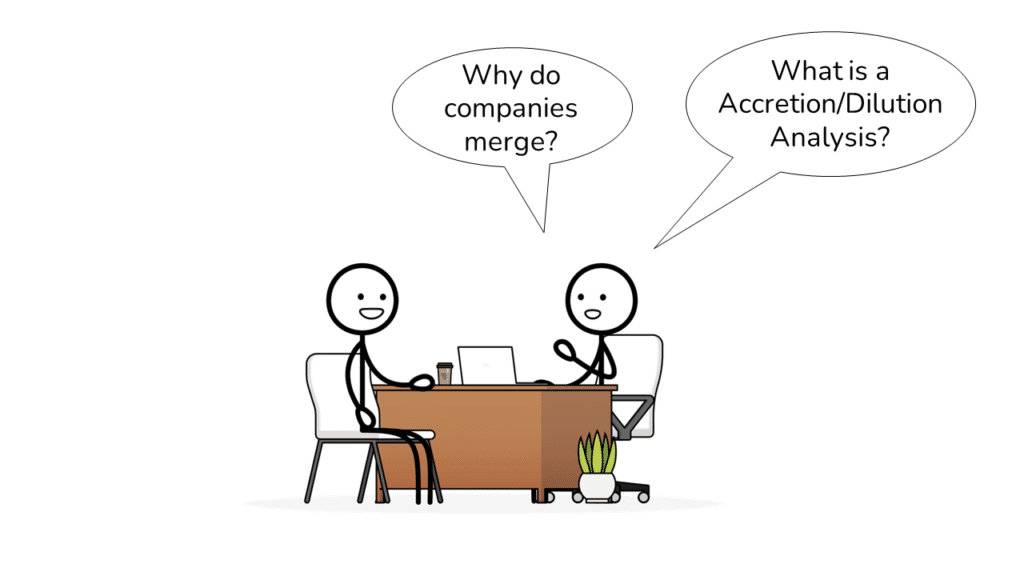
Level 1 M&A Questions
Why do companies merge?
While are many reasons that companies merge the underlying driver of most M&A deals to expedite growth and/or generate cost savings to create value for the owners of the business.
When people say that M&A is an ‘art’ and a ‘science’, what does that mean?
The science refers to the mechanical valuation methods (Comps, DCF, etc.), but the art is in making a judgment call on valuation based on the outputs of the various valuation methodologies.
Who can pay more when buying a company: a Financial buyer or Strategic buyer? Why?
Strategic (i.e. corporate) buyers can typically pay more than Financial (i.e. Private Equity) buyers because strategic buyers typically have overlapping operations that can be removed post-merger to generate cost savings (i.e. Synergies).
When are sponsors and corporate buyers on equal footing?
When a Financial buyer already owns a competing asset, they can generate synergies (which justifies a higher price) and thus are on more equal footing with Strategic buyers.
A common example of this is a ‘roll-up’ strategy where a PE firm buys a series of businesses, and each additional acquisition creates cost savings (i.e. synergies).
What is Accretion/Dilution?
Accretion Dilution in the context of M&A simply describes whether Earnings Per Share for the Acquiring company increase (Accretion) or decrease (Dilution) following the acquisition of a target business.
For a deeper dive, check out the following video:
- Accretion Dilution Analysis in Plain English (Video)
- Accretion Dilution Analysis – The Ultimate Guide (Article)
What is the difference between a ‘Sell-Side’ and a ‘Buy-Side’ M&A deal?
In a sell-side M&A deal, an Investment Bank is hired by a client to sell the client’s business.
In a buy-side M&A deal, an Investment Bank is hired by a client to help them find and execute the purchase of a business.
Learn more about how banks execute Sell-Side and Buy-Side deals in this simple explainer video.
Level 2 M&A Questions
If a company with a PE of 13x buys a company with a PE of 10x in an all-stock deal, is the deal accretive or dilutive?
The deal will be Accretive for the acquiring company because the value of its stock per dollar of earning is greater than that of the target company.
As a result, it will need to issue fewer proportional shares per dollar of earnings to buy out the Target company’s stock.
This is a question that many people simply memorize the answer to but can’t explain the ‘why’ behind the question.
The short story here is that the combined share counts of the company shrink in this type of deal (because the Acquirer’s stock is more valuable), but Net Income remains the same, so as a result, Earnings Per Share increases.
For a deeper dive, check out the following video:
- Accretion Dilution Analysis in Plain English (Video)
- Accretion Dilution Analysis – The Ultimate Guide (Article)
What are the typical structures for an M&A deal?
The three typical structures are asset acquisition, stock purchase, and merger.
What is an Acquihire?
An Acquihire is an acquisition of a target company with the primary goal of bringing in the target company’s team to work at the acquiring company.
What is an earnout?
When a seller agrees to receive a portion of the purchase price in an acquisition based on the operating performance of the business following an acquisition.
Payment is typically based on achieving Revenue and/or EBITDA growth milestones over time.
Do sellers like/dislike earnouts? How about buyers?
Earnouts typically benefit the buyers instead of the sellers since they protect the buyer by implementing profitability requirements for the full payout to the seller.
What are the forms of consideration in an M&A deal and what are the implications of each?
The primary forms of consideration are Stock, Cash, and Debt.
Key Implications:
- Stock – increases the post-deal share count.
- Debt – creates new interest expense.
- Cash – creates foregone interest income expense which reflects the missed interest that could have been earned on the cash used in the deal.
Level 3 M&A Questions
What is the P/E of Cash and Debt?
The P/E of Cash and Debt reflects the inverted after-tax cost of Cash and Debt in an M&A deal.
Does an Asset or Stock deal typically create a Deferred Tax Liability?
A Stock Deal typically creates a Deferred Tax Liability because in a Stock Deal there isn’t a step-up in basis for Tax purposes, which creates a disconnect between GAAP and IRS Tax Expense.
Is Goodwill amortization tax-deductible in an Asset Sale? Stock Sale?
Goodwill amortization is tax-deductible in Asset Sale but not in a Stock Sale .
Do buyers generally prefer asset sales or stock sales? Why?
Buyers often prefer Asset Sale structures because the Asset sale structure creates a step-up in basis. The increase in basis creates to tax savings via increased Depreciation and Amortization expense over time, which arises from the Purchase Price Allocation process.
IB Interview Questions: LBO
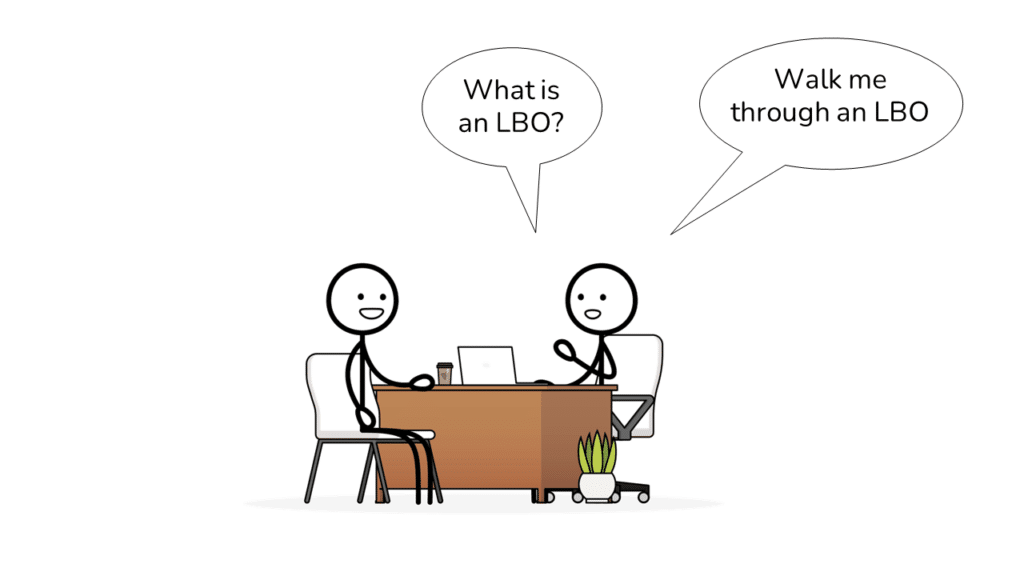
Level 1 LBO Questions
What is an LBO?
LBO stands for ‘Leveraged’ Buyout which is an acquisition of a company in which a meaningful portion of the deal funding comes from Debt.
Why do PE firms acquire with Debt as opposed to purchasing outright with equity?
By using leverage, Private firms can increase the return on the money they invest by putting less money upfront, while still capturing the cash flow and appreciation of the business over time.
What are the underlying value creation drivers in an LBO?
The primary value creation drivers are Purchase Price, EBITDA growth, and Cash Flow.
Secondary drivers include the level of Debt at purchase, the interest rate on the Debt, and the Exit multiple.
The latter group are secondary as they are all typically not within the control of the PE firm.
What is the difference between a levered and unlevered return?
The Unlevered return on any asset reflects the pure profit (ideally Cash Flow), excluding the impact of Debt, generated by the Asset relative to the Purchase Price/Value of that asset.
Conversely, the Levered return on any Asset takes into account the impact of Interest payments on Debt on Cash Flow relative to Equity Purchase Price/Value.
What makes an ideal LBO candidate?
The ideal LBO Candidate has: 1) Steady/Recurring Cash Flows, 2) Low Reinvestment Needs, 3) Strong Management, and 4) Strong Exit Options
What metrics are typically used to measure returns in an LBO?
The Internal Rate of Return (IRR) or the Multiple of Invested Capital (MOIC).
What is an Internal Rate of Return (IRR)?
IRR reflects the underlying rate of return for a set of future cash flows.
More formally, the IRR reflects the discount rate at which the Net Present Value of a set of cash flows equals zero.
What is the typical target return for PE funds?
Most PE funds target between a 15-25%+ annual rate of return.
The targeted rate of return varies significantly depending on the size and riskiness of each investment.
What is a ‘platform’ or ‘roll-up’ strategy?
With a platform or roll-up strategy, a Private Equity firm will acquire an initial (or ‘Platform’) business and then acquire multiple additional (‘add-ons’ or ‘tuck-ins’) businesses combing into a single company with an aim to generate synergies and to drive increased growth.
What are the typical options for exiting an LBO transaction?
Private Equity firms can either sell the company to a strategic buyer, sell the company to another PE firm (a ‘Secondary Buyout’), or take the company public through an IPO.
What is a dividend recapitalization (or ‘Dividend Recap’)?
In a Dividend recapitalization, a Private Equity firm takes out additional debt and pays itself a dividend.
This usually occurs when a company has performed well and has extra debt capacity, but the Private Equity firm isn’t yet ready to sell the business.
Where does LBO fit into the overall PE Landscape?
Leveraged Buyouts are considered ‘Late Stage’ as most LBOs acquisitions involve more mature businesses.
Level 2 LBO Questions
Walk me through an LBO?
There are six major steps to answer this question:
- Calculate Purchase Price (or ‘Enterprise Value)
- Determine Debt and Equity Funding
- Project Cash Flows
- Calculate Exit Sale Value (or ‘Enterprise Value’)
- Work to Exit Owner Value (or ‘Equity Value’)
- Assess Investor Returns (IRR or MOIC)
Remember to initially keep your answer high-level and let the interviewer pull you into the details.
If you want to master this question, check out our deep-dive Walk me through an LBO.
This is far and away one of our most popular articles as it covers all LBO concepts from start to finish. Definitely check it out!
If IRR is time-weighted, why do we use MOIC?
IRR can be easily distorted by factors like an early exit.
And at the end of the day, PE firms are paid based on absolute dollars returned to investors. So, PE firms look at the MOIC in conjunction with dollars invested to assess the absolute dollars returned for a deal.
How can you buy a company for $500M, then sell it for $500M 5 years later, but triple your investment?
I can borrow $400M of the Purchase Price and invest $100M of Equity.
Then I use the cash flows of the business to pay off $100M of debt.
I exit with a $500M Sale Price – $300M Debt = $200M Equity (2.0x Return).
For a deeper dive, check out the following video:
All else equal, would you prefer to sell to a sponsor or strategic/corporate buyer?
You would typically prefer to sell to a Strategic/Corporate buyer because they can typically pay a higher price due to synergies.
What is Rollover Equity?
When management of a company sold in an LBO transaction retains ownership in a company following an LBO transaction.
What is LIBOR? What about SOFR?
The London Interbank Offered Rate (LIBOR) is the benchmark interest rate major global banks use to lend to one another.
LIBOR will be phased out in the coming years and will be replaced by the Secured Overnight Financing Rate (SOFR).
To learn more, check out this article.
What is the difference between Loan (i.e. ‘Bank’) and bond debt?
Loan debt is typically more senior and consists of Revolving Credit Facility and Term Loan instruments.
Bond Debt is an entirely separate category of debt that is generally more junior in an LBO transaction.
What are Maintenance vs Incurrence covenants?
Maintenance covenants must be tested frequently (typically quarterly). If the company doesn’t meet the covenant, it’s typically an Event of Default.
Maintenance covenant arrangements are most common with Loan debt.
By contrast, Incurrence covenants are only tested when a company issues new debt (or has a major corporate action like an Acquisition).
Incurrence covenant arrangements are most common with Bond debt.
What is ‘Covenant Lite’ debt?
Covenant lite debt describes debt that has either lenient covenants or no covenants at all.
‘Covenant Lite’ debt arises when there exists significant competition among lenders.
What are the most common Leverage and Coverage Ratios for debt in an LBO transaction?
Leverage Ratio: Net Debt / EBITDA
Coverage Ratio: EBITDA / Interest Expense
What is PIK interest?
Paid-In-Kind (PIK) interest is non-cash interest that is added to the Debt principal balance in each period in lieu of the borrower paying cash interest.
Level 3 LBO Questions
What is the least preferred exit method in PE?
The least common exit option is an IPO because of the time needed (often 6+ months from filing) and because the PE firm is often prevented from selling for 6 months post-IPO.
With that said, PE firms do sometimes take companies public to exit, especially if public company valuations are very attractive.
What is an ‘effective’ multiple as opposed to an ‘optical’ multiple?
An optical multiple shows the purchase price of a business relative to the stated profit (typically EBITDA) at the time of the acquisition.
In contrast, to calculate an effective multiple, we look at purchase price relative to profit (again typically EBITDA) incorporating improvements in the business.

